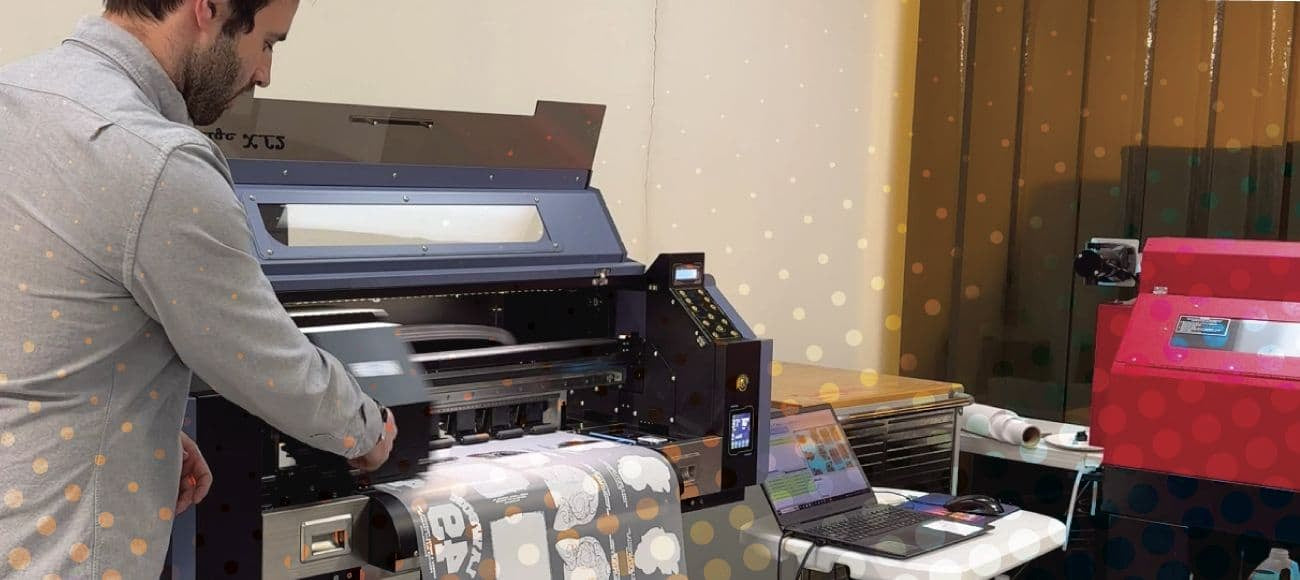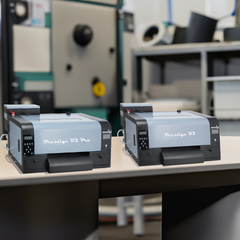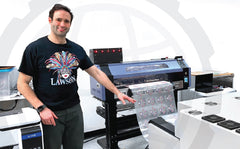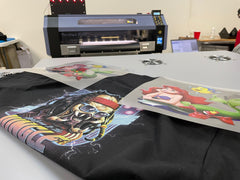A Primer on DTF, What It Is and How It Works
Direct-to-film (DTF) is a new technology to the printing industry and there are a lot of questions about what it is, how the equipment works and how the process works. This frequently asked questions (FAQ) guide aims to educate for those new to, or exploring, DTF printing.
Since DTF is a new process, it is helpful to establish a basic understanding of what it is. In its essence, DTF is a printing process of digitally printing pigment based ink onto a clear film that can then be heat transferred onto many different types of garments, including t-shirts, hoodies, and hats, along with substrates like signs, mugs and other ASI items.
DTF Equipment & Operation Questions:
Q: How does a DTF Printer function?
A: All DTF Printers function by printing CMYK followed by white ink onto a specially coated piece of film. Unlike direct-to-garment (DTG) printing, DTF prints in “reverse order.” This means that the colors are printed first, followed by the white ink.
Q: What type of maintenance is needed for DTF Printers?
A: As an inkjet printer, a DTF printer does require some maintenance that primarily consists of print head maintenance.
Q: Do I need special software or a RIP program to print DTF?
A: Yes. DTF printers require rip software and/or special software to operate. The degree and quality of the software variety as some software can be basic, while others allow for a lot of control. The most control you have over things like color profiling and picoliter (ink drop) size provide for higher quality DTF prints.
Q: Is An Automatic DTF Powder Machine Necessary?
A: No. You do not need an automatic DTF powder applicator for DTF printing. Automatic DTF Powder Machines are most often used with production DTF printing for those printing roll-to-roll. Those printing sheets of DTF transfers do not use an automatic powder machine.
DTF Supplies and Process Questions:
Q: What Type of Ink is Used in DTF?
A: DTF uses a pigment based ink. The colors are printed through a 4-color process using Cyan, Magenta, Yellow and Black (CMYK) with White ink printed on top. The colors are printed in this reverse order because when pressing the DTF transfer onto the fabric, the white ink must be on the bottom.
Q: What Type of Film is Used in DTF?
A: DTF uses PET films with a special coating designed for accepting DTF ink, and importantly, releasing it when combined with heat and pressure (heat press) onto your shirt. These PET films are generally about .75 to 1 mm thick and available in sheets and rolls.
Q: What is the Difference Between Hot Peel and Cold Peel DTF Film?
A: DTF hot peel versus cold peel film refers to the film’s temperature for peeling after heat pressing it. With a hot peel, you peel immediately after heat pressing. A cold peel must cool first. This cooling period is usually about 5 - 10 seconds after it is heat pressed. Cold Peel does not mean the transfer has to be truly “cold”. Most people prefer a hot peel film that gives a softer feel to the print. Cold peel has a more glossy, thicker feeling finish.
Q: Is DTF Limited to just Cotton or Polyester Shirts?
A: No. Unlike other printing methods like direct-to-garment (DTG) or dye-sublimation, a DTF transfer can go onto any type of garment, including cotton, 50/50, polyester and tri-blends.
Q: Must I Apply a DTF Transfer As Soon As It Is Printed?
A: No. You can either press a DTF transfer as soon as it is ready or store it for later application. This allows you to pre-print designs and images for later use, or to print and mail DTF transfers to others.
Q: What are the time, temperature and pressure settings for my heat press?
A: There are no standard settings as the answer varies depending on the transfer and the type of item you are transferring the image onto. Generally speaking, your heat press temperature will be around 300 - 325 degrees Fahrenheit (F) and the pressing time will be about 12 - 15 seconds. Most DTF transfers work best with a medium pressure.
Q: What is DTF Powder and Do I Need It?
A: You must use DTF powder as this is how the DTF transfers stick to the shirt or item. DTF powder is a white granular product that often comes in different “grinds” - regular, medium and course. Finer powder often results in a softer “hand” (feel) of the transfer after pressing.
Q: How Do I Apply DTF Powder?
A: DTF powder application can either be done automatically or manually. Automatic application typically involves roll-to-roll printing with the film passing through a powder application station before moving into a curing oven to melt the powder. At the end, the roll of film comes out and is rewound. Manual powder application is best for sheets since it requires pouring powder onto the still wet transfer and rocking the transfer film back and forth to thoroughly cover the ink with powder.
Q: How Do I Melt the DTF Powder?
A: You can melt the powder a few different ways. The most common (and most economical) way is with a heat press. Make sure to just hover the heat press over the transfer when melting the powder as the powder and the heat press element should not come into contact with each other. Otherwise, the powder will stick to the top of the heat press and ruin the DTF transfer. Other ways to melt DTF powder are with a curing box/oven or by running the DTF transfer through a conveyor dryer.
Q: How is DTF Different from Heat Transfer Vinyl (HTV)?
A: Vinyl transfers require weeding the design and potentially layering vinyl for multi-color designs. This creates a heavy “hand” or feel to the shirt. DTF requires no weeding and is made with just an inkjet printer.
Q: Do I Need to Pre-treat with DTF?
A: No. It is not necessary to pre-treat with the DTF process.




